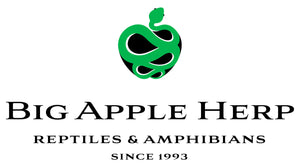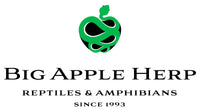Care Sheet For Western Hognose Snakes
Western Hognose Snakes are one of the most unique and entertaining snake species available today. They have gained popularity due in part to their attractive coloration, relatively small size, gentle nature and unique behaviors. Hognose Snakes exhibit harmless defensive mechanisms including hissing, flattening their heads and bodies and even playing dead. They are fun to observe and easy to handle. Females may grow to about 3 feet at the largest, and males up to 2 feet. Given the proper care, the Western Hognose can live over 15 years in captivity. At Big Apple Pet Supply, we carry only Captive Bred Western Hognose Snakes to maintain strict quality control.
Housing
Baby Western Hognose Snakes can be set up in an enclosure as small as 5 gallons but adults should be housed in a larger enclosure of 20 gallons. Western Hognose are not climbers so opt for a longer enclosure versus taller. Always make sure your enclosure includes a secure screen top. We recommend housing Hognose snakes individually.
Substrate
Zoo Med Aspen Snake Bedding is generally the best substrate for Western Hognose Snakes. Babies can also be kept on paper towels or similar product until they become juveniles. Whichever you decide to use, stick to well-known products designed for use with reptiles and be careful of some commercial aspen brands as they may contain high amounts of dust or other contaminants that that can be harmful to your pet. Hognose Snakes like to burrow so provide at least 1” of substrate.
Heating
Western Hognose Snakes need a thermal gradient consisting of a warm side in the upper 80s, a cool side in the upper 60s/low 70s and a basking area around 90° F. Nighttime temperatures can be in mid to high 70s. The best way to heat your Western Hognose Snake’s enclosure is with a combination of heat mat and ceramic heat emitter. We recommend the Intellitemp Heat Mat and Big Apple Black Heat Infrared Ceramic Heat Emitter. The heat mat and ceramic heat emitter should be on one side while the other side should not have any heat source. We recommend controlling the ceramic emitter with a thermostat, such as the BAH-500 or BAH-1000DC, and monitoring the temperatures with a thermometer.
Lighting
While Western Hognose Snakes do not require UV lighting, they are diurnal and do best with 14 to 16 hours of light daily. Exo-Terra Sun-Glo Neodymium Lamps provide both heat and light and are a good choice for these snakes. If you use a bulb for lighting, make sure to maintain proper heat levels; do not exceed 90° F as this could be detrimental to your snake's health.
Shelter
Western Hognose Snakes do well with little furnishings since they like to burrow under their substrate. You should still provide at least two hide boxes, such as a Big Apple Basic Reptile Hide Box, or logs, decorative reptile shelter, hiding huts or caves. It is always a good idea to have one shelter on the warm side and one on the cool side. If you choose to make a hiding place yourself, please make sure it is sturdy enough that there is no potential for collapsing and crushing your snake.
Shedding
Western Hognose Snakes shed their entire skin all at once. Babies shed more often than adults because as babies they outgrow their skin faster. You'll note shedding time when your snake's eyes turn a shade of blue and become cloudy. Snakes normally shed their skin easily but sometimes they have issues if they do not have the proper humidity while shedding. However, in general, Western Hognose Snakes should be maintained in a dry environment. Providing a water bowl large enough for soaking but not so large the animal cannot easily get out of the bowl is all that is needed.
You need to check your snake after it has shed to make sure it was able to peel all the skin off, especially around the eyes. If unshed skin is not removed promptly serious health issues can form. If your Western Hognose Snake has retained skin after shedding you can place the snake in a plastic container lined with warm, wet paper towels with the container lid on or soak the snake in warm water. Let the snake stay in the container or warm water for approximately 30 minutes. The high humidity in the container or using the soaking method should loosen the skin enough to allow you to remove it easily with a pair of tweezers. If the skin has not loosened enough, reheat the paper towels with warm water and provide another 30 minute session. NEVER use hot water as this can burn your snake.
Water
It is essential that you provide your Western Hognose Snake with a large water bowl. The bowl should be large enough that the snake can soak its entire body but not so big that it might have a difficult time getting in or out of the bowl. Place the water dish on the cool side of the cage so that it does not evaporate quickly.
Food
Western Hognose Snakes eat mice and the size of the prey should be about the same diameter as the snake’s head. The prey item should leave a readily noticeable lump in the snake. This is fairly standard for all species of snakes. Hatchling Western Hognose Snakes are typically fed every 5 days while adults are typically fed weekly. Western Hognose Snakes will sometimes present an open mouth at feeding time and may strike at their prey from any direction. For this reason, we recommend presenting the prey animal using a hemostat or forceps.
Feeding live or pre-killed is a question we are often asked. Opinions vary on this subject but we are emphatic that thawed frozen rodents are a much better option. First, feeding thawed rodents is easier and second it's substantially less expensive because you can purchase rats or mice in bulk and then store them in the freezer. More importantly, it is significantly safer for the snake. The bottom line is a thawed prey mouse or rat will never bite or chew on your snake in defense. We have seen nasty rodent bites inflicted on snakes when fed live rodents. We suggest you play it smart and go with feeding thawed prey items. At Big Apple Pet Supply, we carry a huge selection of frozen feeders that we deliver right to your door.
Vitamins
It is important to feed high quality rodents to your snake and it is always a good idea to coat the rodent with a bit of vitamin and calcium powders before feeding them. We carry a full line of quality reptile vitamins and calcium, such as Herptivite Vitamins, Rep-Cal Calcium and Zoo Med Repti Calcium.
Cage Maintenance
Western Hognose Snakes require minimal maintenance as they usually excrete small amounts of semi-solid fluid. Aspen bedding allows for quick cleaning of feces using one of our scoopers. Be sure to add fresh bedding after scooping waste to maintain enough substrate for burrowing. The bedding should be completely thrown out and the entire cage (including all accessories) should be washed at least once every four to five months with Quat TB Pet Area Cleaner, Deodorizer & Stain Remover or a mild detergent. If using paper towels, change all paper towels at least once a week.
Hibernation
Hibernation while being natural for Western Hognose Snakes in the wild is not necessary for pet Western Hognose Snakes. We believe you should heat your Western Hognose Snakes throughout the winter so that they continue to eat, drink and be active. A general reduction in feeding behavior is normal during winter months due to temperature fluctuations in your house. As long as they keep fairly consistent weight it is generally not an issue and normal feeding typically resume in the spring.


